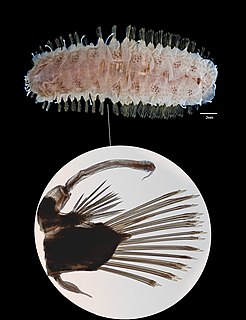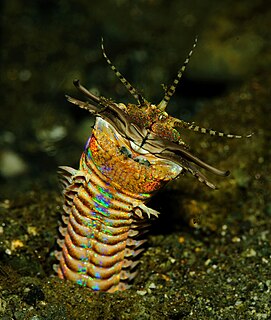
In invertebrates, the term parapodium refers to lateral outgrowths or protrusions from the body. Parapodia are predominantly found in annelids, where they are paired, un-jointed lateral outgrowths that bear the chaetae. In several groups of sea snails and sea slugs, 'parapodium' refers to lateral fleshy protrusions.

Eunicida is an order of polychaete worms.

Phyllodocida is an order of polychaete worms in the subclass Aciculata. These worms are mostly marine though some are found in brackish water. Most are active benthic creatures, moving over the surface or burrowing in sediments, or living in cracks and crevices in bedrock. A few construct tubes in which they live and some are pelagic, swimming through the water column. There are estimated to be about 3,500 species in the order.
Haplosyllis spongicola, the sponge worm, is a species of polychaete worm in the family Syllidae. It was previously classified as Syllis spongicola and is part of a species complex of closely related species that are difficult to distinguish morphologically and where the demarcation between them is unclear. It is found in shallow temperate, subtropical and tropical seas worldwide, wherever its host sponges are found.
Prosphaerosyllis battiri is a species belonging to the phylum Annelida, a group known as the segmented worms. The species name comes from an Aboriginal word, battiri, meaning "rough". Prosphaerosyllis battiri is a species characterized by having only partially fused palps, an unretracted prostomium on its peristomium or showing only slight retraction, the shape of its dorsal cirri and its arrangement of papillae, being numerous anteriorly while less numerous posteriorly. It resembles Prosphaerosyllis semiverrucosa, but its arrangement of dorsal papillae is reversed.
Salvatoria pilkena is a species belonging to the phylum Annelida, a group known as the segmented worms. The species name comes from an Aboriginal word, pilkena, meaning "different", due to its characteristic features. Salvatoria pilkena belongs to a reduced group of species that possess rugose dorsal cirri, contrary to the typical spindle-shaped cirri found in its genus. It also lacks dorsal cirri on chaetiger 2. It resembles Salvatoria swedmarki and S. celiae, differing from pilkena in that the latter has significantly longer proventricles, while its compound chaetae are short and unidentate. At the same time, S. opisthodentata has a similar body and compound chaetae but appears to possess dorsal cirri on its chaetiger 2.
Erinaceusyllis, previously known as Sphaerosyllis, is a genus belonging to the phylum Annelida, a group known as the segmented worms. This genus consists of several species that were previously described as Sphaerosyllis and as Sphaerosyllis erinaceus sub-species, differing by the compound chaetae.

Sphaerosyllis levantina is a species belonging to the phylum Annelida, a group known as the segmented worms. It was first described from Haifa Bay in the eastern Mediterranean. It is similar to Sphaerosyllis hystrix, and is thought to show a cosmopolitan distribution. Its name derives from its type locality, levantina being the feminine form of a neo-Latin adjective meaning "pertaining to the region where the sun raises"; the adjective is feminine to agree with the feminine genus name, Syllis being a river nymph in Greek mythology.
Erinaceusyllis ettiennei is a species belonging to the phylum Annelida, a group known as the segmented worms. E. ettiennei is characterized by its compound chaetae with slender and thin blades, which are curved as a sabre. The most similar species is Erinaceusyllis serratosetosa, but is differentiated by the size of its body and the compound chaetae, which have long and curved marginal spines on its long blades in E. serratosetosa. The species is named in honour of Ettienne Fourie.
Erinaceusyllis cirripapillata is a species belonging to the phylum Annelida, a group known as the segmented worms. E. cirripapillata is characterized by its papillae on its dorsal cirri, one of them being distinctively mushroom-shaped. No species of this genus or Sphaerosyllisis is known to possess this particular kind of papillae. The name of the species refers to these same papillae.
Erinaceusyllis hartmannschroederae is a species belonging to the phylum Annelida, a group known as the segmented worms. This species was previously described in Australia as Sphaerosyllis erinaceus and S. erinaceus erinaceus, a species distributed throughout the globe. These species appear to be a species complex. Previous descriptions stated that the two aforementioned species possess compound chaetae blades which are long and slender. Several subspecies of S. erinaceus were described on the basis of differences in shapes and sizes of their compound chaetae; such differences are enough to consider them as distinct species. The species is named in honour of Gesa Hartmann-Schröder, an expert on syllid species.
Erinaceusyllis kathrynae is a species belonging to the phylum Annelida, a group known as the segmented worms. E. kathrynaen is similar to E. cirripapillata, but lacks characteristic papillae on its cirri. At the same time, Sphaerosyllis perspicax - which according to San Martín (2005) could belong to the genus Erinaceusyllis - is also similar, but its anterior dorsal cirri are inflated at their bases; the eyes and antennae are arranged linearly, and the palps are fused along their length. This species is named in honour of Kathryn Attwood of the Australian Museum.
Sphaerosyllis bardukaciculata is a species belonging to the phylum Annelida, a group known as the segmented worms. Sphaerosyllis bardukaciculatan is similar to Sphaerosyllis aciculata from Florida; its chaetae are almost identical; the former, however, differs by having longer antennae and anal cirri, as well as parapodial glands with granular material. The animal's name is derived from the Aboriginal word barduk, meaning "near", alluding to the aforementioned likeness with S. aciculata.
Sphaerosyllis voluntariorum is a species belonging to the phylum Annelida, a group known as the segmented worms. This species is closely related to Sphaerosyllis bifurcata, Sphaerosyllis bifurcatoides and Sphaerosyllis rotundipapillata, all endemic species to Australia, characterized by having large dorsal papillae, sometimes trilobed, and with shafts of compound chaetae distally bifid. S. voluntariorum is more densely papillated on its anterior segments and has a long subdistal spine on the ventral simple chaetae. This species' name alludes to the volunteers of the Marine Invertebrate section of The Australian Museum, who sorted specimens of syllids that led to the description of this animal.
Sphaerosyllis goorabantennata is a species belonging to the phylum Annelida, a group known as the segmented worms. Sphaerosyllis goorabantennata is distinct by its small size, small and unevenly distributed papillae, as well as by its particularly long antennae and tentacular cirri. Sphaerosyllis minima and S. minima magnapapillata are also small, but their antennae and tentacular cirri are significantly shorter, like its cogenerate species. The species' name is derived from the Aboriginal word gooraba, meaning "big", alluding to its long antennae.
Sphaerosyllis georgeharrisoni is a species belonging to the phylum Annelida, a group known as the segmented worms. Sphaerosyllis georgeharrisoni is distinct by its large parapodial glands with hyaline material; by its small size; short proventricle; a median antenna that is inserted posteriorly to the lateral antennae; as well as long pygidial papillae. Juveniles of S. hirsuta are very similar to this species. Sphaerosyllis pygipapillata has all of its antennae aligned, a smooth dorsum, while its pygidial papillae are longer and slender. The species' name honours George Harrison, musician who died prior to the species' describing article's publication.
Parapionosyllis winnunga is a species belonging to the phylum Annelida, a group known as the segmented worms. Parapionosyllis winnunga is characterized by the shape of the blades of its compound chaetae, which have a long subdistal spine, in turn much longer than in other cogenerate species. Its species name is derived from the Aboriginal word winnunga, meaning "small".
Ophryotrocha craigsmithi is a species of polychaete worm. O. craigsmithi is named after Craig R. Smith. This species is similar to Palpiphitime lipovskyae and O. Platykephale, among others, in having branchial structures dorsally and ventrally. It differs from O. platykephale in the shape of its prostomium and parapodia. Palpiphitime lipovskyae has jaws of both P- and K-type, while no specimens of O. craigsmithi have been found with K-type jaws thus far. Ophryotrocha craigsmithi differs from P. lipovskyae genetically, but also by the presence of a prominent ventral chaetal lobe with a bulging simple chaeta in the former.

Ramisyllis multicaudata is a species of polychaete worm in the family Syllidae. It was found in Darwin Harbour, Australia, where it was living within the tissues of a sponge of the genus Petrosia. It was the second branching species of polychaete worm to have been discovered, the first having been Syllis ramosa, a deep water species, more than a century earlier.

Leucia is a genus of marine polychaete worms belonging to the family Polynoidae, the scaleworms. Leucia contains 2 species, both found in the northern Atlantic Ocean. This genus is distinguished from the closely related genus Harmothoe by having sixteen pairs of elytra, as opposed to fifteen.





